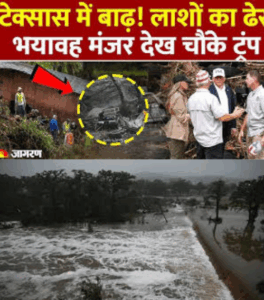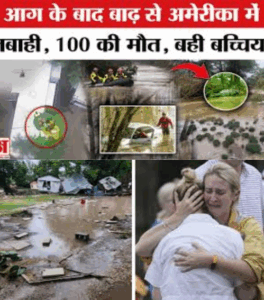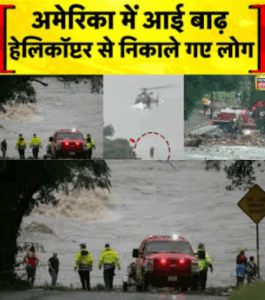Texas Flood Update: Floods wreak havoc in America, Trump arrives to take stock
In early July, Central Texas was slammed by a flash flood so catastrophic it has become the deadliest inland flood in the United States in nearly half a century. Torrential rain, driven by a mesoscale convective vortex tied to remnants of Tropical Storm Barry, unleashed unprecedented rainfall—some areas recorded over 20 inches in just hours—swelling the Guadalupe River and drowning towns in the Hill Country. In Kerr County, a dramatic surge of roughly 26 feet in under an hour transformed campgrounds and riverbanks into watery graveyards. At least 129 people have perished, including dozens of children from the Camp Mystic summer camp, with around 170 still missingThe Texas Tribune+5Wikipedia+5WSB-TV Channel 2 – Atlanta+5.
Locals, first responders, and volunteers plunged into the murky aftermath, wading through debris-laden rivers and mud to retrieve bodies, locate the missing, and help survivors. Some dramatic rescues have surfaced: one off-duty officer bridged a torrent with a garden hose to rescue stranded campers; another chased people clinging to trees in swirling currents. Authorities have underlined their commitment to continue searching until every missing person is accounted forWSB-TV Channel 2 – Atlanta.
Governor Greg Abbott, leading the charge, has vowed that teams won’t rest until every missing individual is found and identified. He’s also demanded a full review of the tragedy and pushed for improved infrastructure and early warning systems. Despite known vulnerability—some county officials previously warned their area needed upgraded alert capabilities—high costs and bureaucratic delays left the region exposed when disaster struck.

Days into the disaster, national attention turned to Kerrville when President Donald Trump and First Lady Melania arrived. They toured the devastation, met with grief-stricken families and first responders, and participated in a high-level roundtable in which Trump pledged federal aid and defended the government’s response efforts. Though he expressed sympathy, he dismissed suggestions that the disaster could have been prevented as “evil” and attributed praise to the speed of the local and federal reaction, even under criticisms that National Weather Service and FEMA budget cuts hampered readinessMySA+11The Washington Post+11San Antonio Express-News+11.
The flood has taken a harrowing toll on communities. Camp Mystic lost 27 girls and staff members who were caught unawares. Across Kerr County, 103 lives ended—67 adults and 36 children—while neighboring counties reported dozens more deaths, taking the total in Texas to around 120−130CNBC+11Houston Chronicle+11MySA+11. Hundreds of stranded residents withstood sweltering heat, debris-choked water, and likely hypothermia while awaiting rescue, only to face the grief of family or scavenging through mud for lost companions and belongings.
In response, state and federal emergency services ramped up. More than 2,000 volunteers joined rescue operations. FEMA has initiated assistance programs, governors have called special legislative sessions, and county officials have begun organizing flood alert systems and deploying trauma counseling teams. A disaster recovery center was established in Kerrville, although turnout was muted in the immediate aftermath, as survivors remained overwhelmedAP News.
Criticism has also emerged—families, first responders, and local officials stress that warning systems failed to reach many residents. Experts and survivors say the speed and intensity of the flood exceeded expectations, yet flash-flood watches had only been issued shortly before the event. Efforts to install flood sirens or real-time alert systems years ago were thwarted by funding limitationsKSAT+4AP News+4The Times+4.
The image of devastation remains striking: aerial photos showing uprooted centuries-old trees, shattered homes, capsized campers, and vehicles scattered like toys testify to nature’s raw power. Amid the carnage, community bonds have strengthened: candlelight vigils, trauma counseling, and volunteer cleanup brigades have drifted through towns scarred by water and sorrow.

As search operations enter their second week, hope remains—families cling to faith that the missing might yet be found, while survivors and residents rebuild what they can. Memorial services have begun, and a benefit concert featuring George Strait is planned to aid survivors in Boerne. Professional sports teams and local nonprofits have pledged support, providing food, shelter, and spirit to communities like Kerrville, Hunt, and beyondMySA+5MySA+5WSB-TV Channel 2 – Atlanta+5.
The flood has led to broader conversations about how America prepares for sudden, extreme weather. Texans—especially those in “flash flood alley”—are demanding better early warning networks. Lawmakers are considering legislation to strengthen flood alerts, deploy sirens, and mandate safety protocols for camps and riverside residents. Governor Abbott’s special session will address funding for disaster communication systemsCNBC.
President Trump’s visit, arriving with political fanfare including television personality Dr. Phil and Texas Senator Ted Cruz, underscored the crisis’s gravity. He described the scene as “like nothing I’ve ever seen,” yet faced scrutiny for refusing to acknowledge possible preventive measures and insisting federal agencies responded effectively despite earlier budget cutsThe Times of India+3The Washington Post+3Wall Street Journal+3.
The Central Texas flood of July 2025 is more than a tragedy—it is a wake-up call. As waters swallowed lives and homes, the event revealed gaps in planning, communication, and response. Families bear scars visible and invisible: loss of loved ones, shattered livelihoods, and emotional wounds. As reconstruction begins, survivors emphasize that recovery is not just physical—it is communal, mental, and structural.
Communities insist that infrastructure be built with foresight, that aid systems be responsive and robust, and that early warnings are no longer optional. As the nation watches Kerrville and surrounding towns pick up the pieces, many hope this disaster will usher in a new era of preparedness, where flood warnings are heard, responses are swift, and communities thrive—safe from the next wall of water.

Governors, local officials, and disaster experts hope that, amid the grief, lessons learned will reshape policies and protection—so next time, flash floods are met with readiness, not desperation. In that quest lies the hope that every lost life becomes a catalyst for change, and every recovered survivor a reminder of resilience in depth and community in crisis.
Play video :
News
Russian woman living with her daughters in a jungle cave for years, found in Karnataka
Russian woman living with her daughters in a jungle cave for years, found in Karnataka In early July 2025, a…
Abdu Rozik Arrested at Dubai Airport Over Shocking Theft Allegations | Full Story Inside
Abdu Rozik Arrested at Dubai Airport Over Shocking Theft Allegations | Full Story Inside . . . Abdu Rozik Arrested…
Humaira Asghar’s Shocking Postmortrm Report revealed Truth of ehr Death after her LAST Voice Note!
Humaira Asghar’s Shocking Postmortrm Report revealed Truth of ehr Death after her LAST Voice Note! . . . The Tragic…
Sad News for Kapil Sharma fans as Kapil Sharma admit To Hospital after Stroke and Breathing issues?
Sad News for Kapil Sharma fans as Kapil Sharma admit To Hospital after Stroke and Breathing issues? . . ….
Radhika Yadav Murder: New twist in tennis player Radhika Yadav murder case, father is misleading the police!
Radhika Yadav Murder: New twist in tennis player Radhika Yadav murder case, father is misleading the police!. . . ….
Television Stars Neil and Aishwarya Announce Official Separation, Request Privacy Amid Emotional Statements
Aishwarya Sharma brokedown after Neil Bhatt’s 2nd Marriage after her DIVORCE ! Television Stars Neil and Aishwarya Announce Official Separation,…
End of content
No more pages to load










